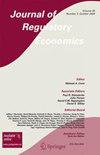光伏发电的采用:净计量下配电电价的作用
IF 1.4
4区 经济学
Q3 ECONOMICS
引用次数: 0
摘要
屋顶太阳能电池板等分散式生产装置(DPU)的部署是向绿色能源过渡的一大挑战。在净计量系统下,当光伏发电量过多时,电表会向后运行,太阳能电池板生产的电力按零售价计价。因此,较高的零售价格会鼓励部署 DPU。为了确定这种关系,我们使用了瓦隆的数据,瓦隆的电价主要以体积为基础,并且有 13 个不同的电价区。通过使用不同的规格,我们的结果表明,在配电电价每千瓦时高一欧分的城市,在其他条件相同的情况下,太阳能光伏发电的投资会增加约 8%。本文章由计算机程序翻译,如有差异,请以英文原文为准。
PV adoption: the role of distribution tariffs under net metering
The deployment of decentralized productions units (DPU) like rooftop solar panels is a major challenge for a transition towards greener energy sources. Under a net metering system where the meter runs backward when there is excessive PV production, the electricity produced by a solar panel is valued at the retail price. Higher retail prices thus encourage the deployment of DPU. To identify this relationship, we use data from Wallonia where tariffs are paid on a mostly volumetric base and where there are 13 different tariff zones. Using various specifications, our results suggest that in a municipality where the distribution tariff is one eurocent per kWh higher, the investment in solar PV is, all else equal, around 8% higher.
求助全文
通过发布文献求助,成功后即可免费获取论文全文。
去求助
来源期刊

Journal of Regulatory Economics
ECONOMICS-
CiteScore
2.40
自引率
0.00%
发文量
14
期刊介绍:
Recent legislative and policy reforms have changed the nature of regulation. Partial deregulation has created a new dimension to regulatory problems, as the debate is extended to include diversification and new forms of regulation. The introduction of incentive-based rate schedules and ratemaking procedures, the integration of demand-side programs with planning for capitol expansion, and other developments, raise a host of theoretical and empirical questions. The Journal of Regulatory Economics serves as a high quality forum for the analysis of regulatory theories and institutions by developing the rigorous economics foundations of regulation. Both theoretical and applied works, including experimental research, are encouraged. Research in all aspects of regulation is of interest including traditional problems of natural monopoly, antitrust and competition policy, incentive regulation, deregulation, auction theory, new policy instruments, health and safety regulation, environmental regulation, insurance and financial regulation, hazardous and solid waste regulation, universal service obligation, and consumer product regulation. The JRE provides researchers, policy-makers, and institutions with current perspectives on the theory and practice of economics of regulation. While there are a number of journals and magazines that include the study of regulation, the JRE is unique in that it fills a gap in the market for a high quality journal dealing solely with the economics of regulation.Officially cited as: J Regul Econ
 求助内容:
求助内容: 应助结果提醒方式:
应助结果提醒方式:


